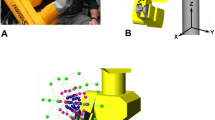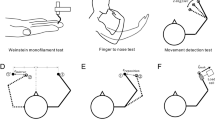Abstract
Sensitivity analysis for a user command controller monitoring head position for artificial control of the proximal upper limb was performed. The controller was evaluated by having subjects complete target matching tasks manipulating a simulated on-screen hand representation to investigate the effects of target location and target speed on performance. Sixteen subjects took part in the study, 11 of whom had sustained cervical spinal cord injuries. The subjects were able to control the on-screen hand with overall low sensitivity of performance with the controller to target position in its five-degrees-of-freedom. The optimal speed was found to be a compromise between low speed and high accuracy but longer completion time and fast speed for short completion time with lower accuracy. The results demonstrated the robustness of the controller across a population of non-injured subjects and those with tetraplegia.






Similar content being viewed by others
References
Adam JJ, Müskens R, Hoonhorst S, Pratt J, Fischer MH (2010) Left hand, but not right hand, reaching is sensitive to visual context. Exp Brain Res 203(1):227–232
Braun DA, Aertsen A, Wolpert DM, Mehring C (2009) Learning optimal adaptation strategies in unpredictable motor tasks. J Neurosci 29(20):6472–6478
Decety J, Jeannerod M (1995) Mentally simulated movements in virtual reality: does Fitts’s law hold in motor imagery? Behav Brain Res 72(1–2):127–134
Diedrichsen J, White O, Newman D, Lally N (2010) Use-dependent and error-based learning of motor behaviors. J Neurosci 30(15):5159–5166
Fitts PM (1954) The information capacity of the human motor system in controlling the amplitude of movement. J Exp Psychol 47(6):381–391
Heck CV, Hendryson IE, Rowe CR (1965) Joint motion: method of measuring and recording. The American Academy of Orthopaedic Surgeons, Chicago
Kirshblum SC, Burns SP, Biering-Sorensen F, Donovan W, Graves DE, Jha A, Johansen M, Jones L, Krassioukov A, Mulcahey MJ, Schmidt-Read M, Waring W (2011) International standards for neurological classification of spinal cord injury (Revised 2011). J Spinal Cord Med 34(6):535–546
LoPresti EF, Brienza DM, Angelo J, Gilbertson L (2003) Neck range of motion and use of computer head controls. J Rehabil Res Dev 40(3):99–211
Memberg WD, Polasek KH, Hart RL, Bryden AM, Kilgore KL, Nemunaitis GA, Hoyen HA, Keith MW, Kirsch RF (2014) Implanted neuroprosthesis for restoring arm and hand function in people with high level tetraplegia. Arch Phys Med Rehabil 95(6):1201–1211
Nagengast AJ, Braun DA, Wolpert DM (2011) Risk sensitivity in a motor task with speed-accuracy trade-off. J Neurophysiol 105(6):2668–2674
Owsley C, Ball K, Keeton DM (1995) Relationship between visual sensitivity and target localization in older adults. Vis Res 35(4):579–587
Resnik L, Lieberman Klinger S, Etter K (2014) User and clinician perspectives on DEKA arm: results of VA study to optimize DEKA arm. J Rehabil Res Dev 51(1):27–38
Schmidt RA, Lee TD (1999) Motor control and learning: a behavioural emphasis, 3rd edn. Human Kinetics, Champaign
Scott TRD, Vare VA (2013) A novel five degree of freedom user command controller in people with spinal cord injury and non-injured for full upper extremity neuroprostheses, wearable powered orthoses and prosthetics. MBEC 51(3):317–330
Scott TRD, Vare VA (2008) Assessment of a user command controller for people with high level tetraplegia to control a full upper limb neuroprosthesis in five degrees of freedom. In: Proceedings of the 5th annual international FES society conference, Freiburg. S3, Freiburg, Germany
Scott TRD, Peckham PH, Keith MW (1995) Upper extremity neuroprostheses using functional electrical stimulation. Bailliere’s Clin Neurol 4(1):57–75
Scott TRD and Vare VA (2012) Artificial control of a full upper limb evaluated using a virtual on-screen arm representation by non-injured people and those with tetraplegia. In: 29th annual scientific research meeting RNSH-UTS-USYD-KIMR, Royal North Shore Hospital Campus, St Leonards, NSW, p 27
Scott TRD, Peckham PH, Kilgore KL (1996) Tri-state myoelectric control of bilateral upper extremity neuroprostheses for tetraplegic individuals. IEEE Trans Rehabil Eng 4(4):251–263
Simpson DC (1974) The choice of control system for the multimovement prosthesis: extended physiological proprioception (e.p.p.). In: Herberts P et al (eds) The control of upper extremity prostheses and orthoses. Charles C. Thomas, Springfield, pp 146–150
Thoroughman KA, Shadmehr R (2000) Learning of action through adaptive combination of motor primitives. Nature 407:742–747
Acknowledgments
Northern Sydney Central Coast Area Health Service Research Grants Scheme. Office for Science and Medical Research NSW Government Biofirst Premiers Grant for Spinal Cord Injury and other Neurological Disorders.
Author information
Authors and Affiliations
Corresponding author
Rights and permissions
About this article
Cite this article
Scott, T.R.D., Vare, V.A. Sensitivity analysis of a novel five-degrees-of-freedom user command controller in people with spinal cord injury and non-injured for full upper extremity neuroprosthesis, wearable powered orthoses and prosthetics. Med Biol Eng Comput 53, 511–523 (2015). https://doi.org/10.1007/s11517-015-1255-1
Received:
Accepted:
Published:
Issue Date:
DOI: https://doi.org/10.1007/s11517-015-1255-1




